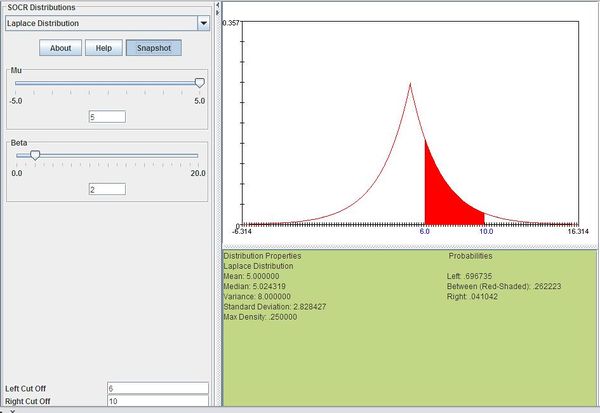Difference between revisions of "AP Statistics Curriculum 2007 Laplace"
(→Laplace Distribution) |
(→Related Distributions) |
||
| Line 41: | Line 41: | ||
===Related Distributions=== | ===Related Distributions=== | ||
| − | *If <math>X\sim Laplace(\mu,b)\!</math>, then <math>kX+b\sim Laplace(k\mu+b,kb)\!</math> | + | *If <math>X\sim \operatorname{Laplace}(\mu,b)\!</math>, then <math>kX+b\sim \operatorname{Laplace}(k\mu+b,kb)\!</math> |
| − | *If <math>X \sim Laplace(0,b)\!</math>, then <math>|X| \sim Exponential(\tfrac{1}{b})\!</math> ([[ | + | *If <math>X \sim \operatorname{Laplace}(0,b)\!</math>, then <math>|X| \sim \operatorname{Exponential}(\tfrac{1}{b})\!</math> ([[Exponential distribution]]) |
| + | *If <math>X \sim \operatorname{Exponential}(\tfrac{1}{\lambda})\!</math> and <math>Y \sim \operatorname{Exponential}(\tfrac{1}{\lambda})\!</math>, then <math>X-Y \sim \operatorname{Laplace}\left(0,\lambda\right)\!</math> | ||
| + | *If <math>X \sim \operatorname{Laplace}(\mu,\tfrac{1}{b})\!</math>, then <math>|X-\mu| \sim \operatorname{Exponential}(b)\!</math> | ||
| + | * If <math>X_i \sim \operatorname{Normal}(0,1)\!</math> for <math>i={1,2,3,4}\!</math> then <math>X_1 X_2 - X_3 X_4 \sim \operatorname{Laplace}(0,1)\!</math> ([[Normal distribution]]) | ||
| + | * If <math>X_i \sim \operatorname{Normal}(0,1)\!</math> for <math>i={1,2,3,4}\!</math>, then <math>X_1 X_2 + X_3 X_4 \sim \operatorname{Laplace}(0,1)\!</math> | ||
| + | * If <math>X_i \sim \operatorname{Laplace}(\mu,b)\!</math>, then <math>\frac{2}{b \sum_{i=1}^n |X_i-\mu|} \sim \chi^2(2n) \! </math> ([[Chi-square distribution]]) | ||
| + | *If <math>X \sim \operatorname{Laplace}(\mu,b)</math> and <math>Y \sim \operatorname{Laplace}(\mu,b)</math> then <math> \tfrac{|X-\mu|}{|Y-\mu|} \sim \operatorname{F}(2,2) </math> ([[F-distribution]]) | ||
===Applications=== | ===Applications=== | ||
Revision as of 16:22, 11 July 2011
Laplace Distribution
Definition: Laplace distribution is a distribution that is symmetrical and more “peaky” than a normal distribution. The dispersion of the data around the mean is higher than that of a normal distribution. Laplace distribution is also sometimes called the double exponential distribution.
Probability density function: For X~Laplace(\(\mu\),b), the Laplace probability density function is given by
\[\frac{1}{2b}\exp(-\frac{|x-\mu|}{b})\]
where
- e is the natural number (e = 2.71828…)
- b is a scale parameter (determines the profile of the distribution)
- \(\mu\) is the mean
- x is a random variable
Cumulative density function: The Laplace cumulative distribution function is given by
\[ \left\{\begin{matrix} \frac{1}{2}\exp(\frac{x-\mu}{b}) & \mbox{if }x < \mu \\[8pt] 1-\frac{1}{2}\exp(-\frac{x-\mu}{b}) & \mbox{if }x \geq \mu \end{matrix}\right. \]
where
- e is the natural number (e = 2.71828…)
- b is a scale parameter (determines the profile of the distribution)
- \(\mu\) is the mean
- x is a random variable
Moment generating function: The Laplace moment-generating function is
\[M(t)=\frac{\exp(\mu t)}{1-b^2 t^2} \mbox{ for }|t|<\frac{1}{b}\]
Expectation:
\[E(X)=\mu\!\]
Variance: The gamma variance is
\[Var(X)=2b^2\!\]
Related Distributions
- If \(X\sim \operatorname{Laplace}(\mu,b)\!\), then \(kX+b\sim \operatorname{Laplace}(k\mu+b,kb)\!\)
- If \(X \sim \operatorname{Laplace}(0,b)\!\), then \(|X| \sim \operatorname{Exponential}(\tfrac{1}{b})\!\) (Exponential distribution)
- If \(X \sim \operatorname{Exponential}(\tfrac{1}{\lambda})\!\) and \(Y \sim \operatorname{Exponential}(\tfrac{1}{\lambda})\!\), then \(X-Y \sim \operatorname{Laplace}\left(0,\lambda\right)\!\)
- If \(X \sim \operatorname{Laplace}(\mu,\tfrac{1}{b})\!\), then \(|X-\mu| \sim \operatorname{Exponential}(b)\!\)
- If \(X_i \sim \operatorname{Normal}(0,1)\!\) for \(i={1,2,3,4}\!\) then \(X_1 X_2 - X_3 X_4 \sim \operatorname{Laplace}(0,1)\!\) (Normal distribution)
- If \(X_i \sim \operatorname{Normal}(0,1)\!\) for \(i={1,2,3,4}\!\), then \(X_1 X_2 + X_3 X_4 \sim \operatorname{Laplace}(0,1)\!\)
- If \(X_i \sim \operatorname{Laplace}(\mu,b)\!\), then \(\frac{2}{b \sum_{i=1}^n |X_i-\mu|} \sim \chi^2(2n) \! \) (Chi-square distribution)
- If \(X \sim \operatorname{Laplace}(\mu,b)\) and \(Y \sim \operatorname{Laplace}(\mu,b)\) then \( \tfrac{|X-\mu|}{|Y-\mu|} \sim \operatorname{F}(2,2) \) (F-distribution)
Applications
The Laplace distribution is used for modeling in signal processing, various biological processes, finance, and economics. Examples of events that may be modeled by Laplace distribution include:
- Credit risk and exotic options in financial engineering
- Insurance claims
- Structural changes in switching-regime model and Kalman filter
Example
Suppose that the return of a certain stock has a Laplace distribution with \(\mu=5\) and \(b=2\). Compute the probability that the stock will have a return between 6 and 10.
We can compute this as follows:
\[P(6 \le X\le 10)=\sum_{x=6}^{10}\frac{1}{2\times 2}\exp(-\frac{|x-5|}{2})=0.262223\]
The figure below shows this result using SOCR distributions
